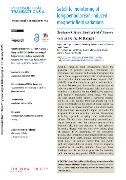Satellite monitoring of long period ocean-induced magnetic field variations

Author
Finlay, Christopher C.
Kloss, Clemens
Blangsboll, Rasmus M.
Publication date
2024Published in
Philosophical Transactions of the Royal Society A: Mathematical, Physical and Engineering SciencesVolume / Issue
382 (2286)ISBN / ISSN
ISSN: 1364-503XISBN / ISSN
eISSN: 1471-2962Metadata
Show full item recordCollections
This publication has a published version with DOI 10.1098/rsta.2024.0077
Abstract
Satellite magnetic field observations have the potential to provide valuable information on dynamics, heat content and salinity throughout the ocean. Here, we present the expected spatio-temporal characteristics of the ocean-induced magnetic field (OIMF) at satellite altitude on periods of months to decades. We compare these to the characteristics of other sources of Earth's magnetic field, and discuss whether it is feasible for the OIMF to be retrieved and routinely monitored from space. We focus on large length scales (spherical harmonic degrees up to 30) and periods from one month up to 5 years. To characterize the expected ocean signal, we make use of advanced numerical simulations taking high-resolution oceanographic inputs and solve the magnetic induction equation in three dimensions, including galvanic coupling and self-induction effects. We find the time-varying ocean-induced signal dominates over the primary source of the internal field, the core dynamo, at high spherical harmonic degree with the cross-over taking place at degrees 13-19 depending on the considered period. The ionospheric and magnetospheric fields (including their Earth-induced counterparts) have most power on periods shorter than one month and are expected to be mostly zonal in magnetic coordinates at satellite altitude. Based on these findings, we discuss future prospects for isolating and monitoring long period OIMF variations using data collected by present and upcoming magnetic survey satellites.This article is part of the theme issue 'Magnetometric remote sensing of Earth and planetary oceans'.
Keywords
geomagnetism, ocean dynamics, remote sensing,
Permanent link
https://hdl.handle.net/20.500.14178/2816License
Full text of this result is licensed under: Creative Commons Uveďte původ 4.0 International







